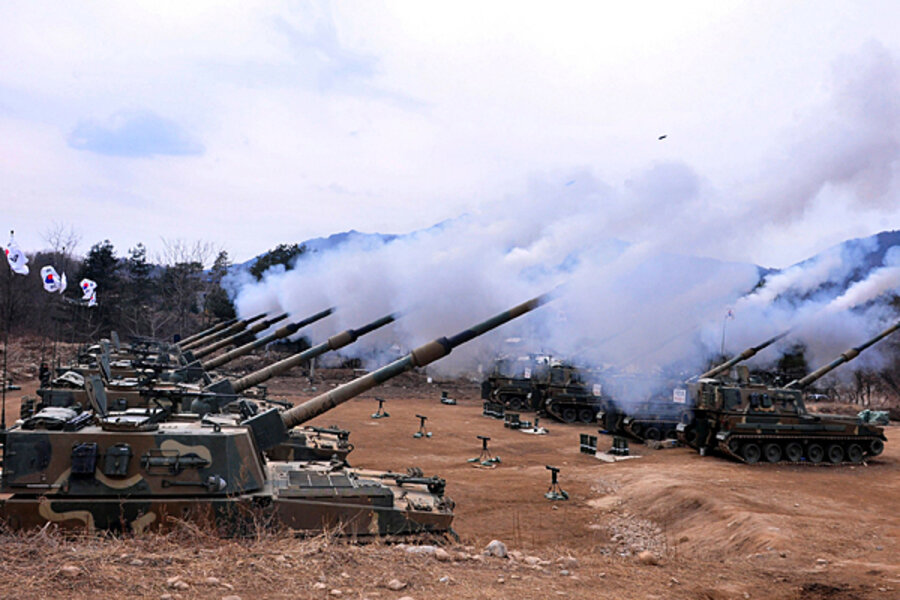South Korea war games put Yeonpyeong Island on edge
Loading...
| Yeonpyeong Island, South Korea
Amid signs of life returning to normal on this tiny South Korean island, months after a deadly attack from North Korea, tensions are again on edge over war exercises to mark the first anniversary of the sinking of the Cheonan naval corvette.
Three days of sea exercises in the water that surround the island started today and will simulate attacks by North Korean submarines, ships, and jet fighters. An international investigation last year into the sinking of Cheonan concluded that it was struck by a North Korean torpedo on March 26, 2010, killing 46 sailors. North Korea denies responsibility.
That attack near Yeonpyeong Island, which sits in the Yellow Sea less than eight miles from the North Korean mainland, only served as a precursor to a direct attack in November, when a deadly North Korean shelling barrage interrupted island life, killing four people, tearing apart homes and businesses, and causing a near total evacuation.
IN PICTURES: North Korean attack
Most of the island's 1,300 residents only returned home about a month ago. Since then they’ve been struggling to rebuild their lives in this sleepy fishing village skirted by farmland and a 1,000-plus military force. For islanders, the sights and sounds of South Korean and American warships now maneuvering around the island are a harsh reminder of the potential for repeat strikes from the North. On Wednesday, the North's military threatened to fire on the South in retaliation for a planned launch of leaflets by activists near the disputed Yellow Sea border.
“When you ask me about the [financial] damage last year, the incident happened just after crab season so in terms of earnings I did not suffer that much,” says fisherman Hwang Ki-sik. “But otherwise, we suffered a lot. You can’t imagine the explosions, and, now, everywhere there are still the burned houses in town.”
Fishermen still hurting
While Mr. Hwang did not face significant losses in the last crab season, fishermen are in a race against time to get their gear ready for the start of next crab season, which begins April 15.
With about 30 percent of the island’s fishing nets still in the water after last November’s hasty retreat to the mainland amid the artillery bombardment, damage to tools and equipment is vast and many wonder whether they will be ready to sail. The estimated cost of a new net is about 10 million won (about $8,900), according to one fisherman, easily bringing the total economic cost to the island's fishermen into the hundreds of thousands of dollars.
“Normally, each fishing boat captain will have 30 sets and for each one 4 to 5 sets are damaged,” says Lee Ki-chul, a crew member, as he fights to free tangled ropes and nets in the island harbor in hope of recovering some of them.
Even yet, there are indications here that life is slowly reverting to some form of normalcy. At an elementary school playground, a group of teenagers kick around a football. In the tight alleyways of the Yeonpyeong village’s disheveled streets, a quartet of uniformed schoolgirls bid jovial farewells. And in the fields between the residential area and the busy marine base, small circles of elderly women sit chatting around plates of food and soymilk.
Rebuilding the island
Most shattered windows have been replaced. A gaping artillery hole in the otherwise unblemished wall of the waterfront football pavilion is ready to be filled in. At the island fish association, a calling has been put out for residents to consider starting seaweed farms, take over vacant buildings, or open restaurants. Many existing enterprises have reopened.
“The major problem,” explains Oh Chang-hwan, a secretary at the local government, “is building up the houses that have been burned.” This, he concedes, “will take quite long.”
Many whose houses were destroyed in November are still staying in temporary huts in the elementary school playground. Questions of land ownership stall rebuilding efforts. And school children, explains teacher Kuk Yoon-joo, are jumpy. "The other day someone slammed a door," he says, "and everyone jumped."
Still, signs of resilience endure. “Stop taking my picture and fix my TV,” quips Kim Su-yun to a photographer, blending wit with an example of how in times of trouble the trivial can be a source of comfort. “I cannot survive with only one channel.”





